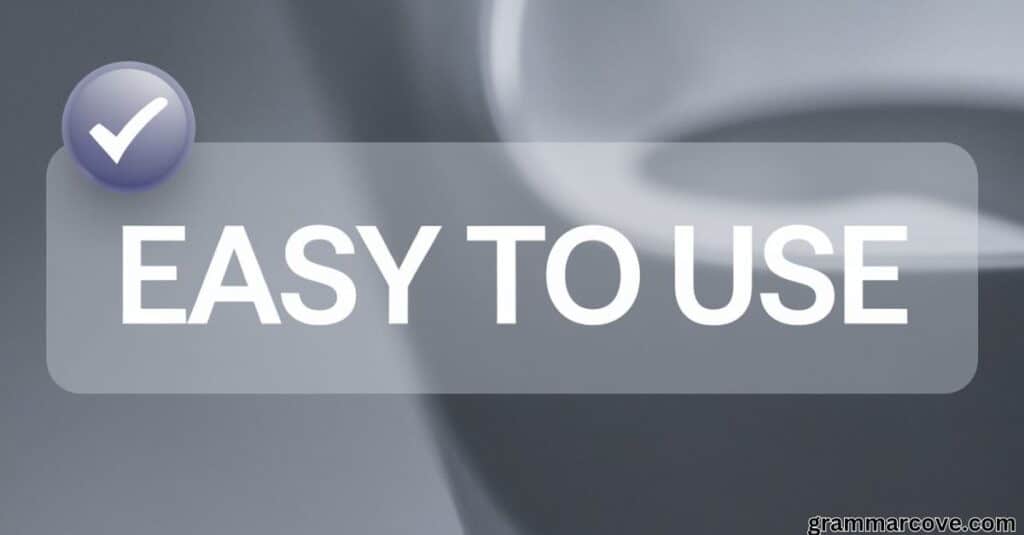When it comes to language, even the smallest details can ignite debate. One such detail involves the hyphenation of phrases like “easy to use” versus “easy-to-use.” The question of easy-to-use or easy to use highlights the importance of understanding when to hyphenate, as this can improve clarity, enhance readability, and ultimately make your writing more effective.
This article delves into these nuances, providing practical scenarios and insights into how the correct usage can affect communication.
The Importance of Clarity in Writing
Effective communication hinges on clarity. When you write, your goal is to convey ideas so that readers easily understand them. Misusing hyphens can muddle your message, leaving readers confused or unsure of your intent. By using the correct form, you not only clarify your meaning but also enhance your credibility as a writer.
Understanding Adjectives and Their Usage
To grasp the distinction between “easy to use” and “easy-to-use,” we must first understand how adjectives function. In English, adjectives can take various forms, sometimes appearing as simple phrases and at other times as compound adjectives. The choice between these forms depends largely on their placement within a sentence.
- “Easy to use” acts as a predicate adjective. It describes the subject after a linking verb.
- “Easy-to-use” is a compound adjective, which modifies a noun directly.
Scenario 1: Email to a Colleague
Let’s look at how these phrases can be applied in real-life situations. Imagine you’re sending an email to a colleague regarding a new software tool:
Subject: Feedback on the New Project Management Tool
Hi Sarah,
I wanted to share my thoughts on the new project management tool we discussed in our last meeting. Overall, I found it easy to use and effective for our team’s needs. The interface is intuitive, which makes it a great choice for anyone, regardless of their tech skills.
If you’d like, I can organize a demonstration for the rest of the team. Let me know!
Best,
John
In this example, “easy to use” serves as a description of the software after the verb “found.” It flows naturally within the context, making John’s opinion clear and straightforward.
Scenario 2: Product Description for a Website
Now, let’s consider a different scenario where clarity and marketing play a crucial role. You’re crafting a product description for a website:
Product Name: SmartBudget App
Description: SmartBudget is an easy-to-use budgeting app that helps you track your finances effortlessly. With its sleek design and user-friendly interface, you can create budgets in minutes.
Here, “easy-to-use” is a compound adjective modifying the noun “app.” This form immediately communicates to potential customers that the app is designed for straightforward use, making it attractive to a broad audience.
When to Use Each Form

Choosing between “easy to use” and “easy-to-use” often boils down to context. If the phrase follows a verb or stands alone, go with “easy to use.” If it appears before a noun, hyphenate it to create “easy-to-use.”
Examples in Context
- Easy to Use:
The application is easy to use.
(This describes the application directly.) - Easy-to-Use:
We’re looking for an easy-to-use application for our project.
(Here, it modifies “application.”)
Enhancing Readability
Using hyphens appropriately enhances readability. Incorrect usage can confuse readers. For example, consider the difference:
Incorrect: We need an easy to use platform.
Correct: We need an easy-to-use platform.
In the incorrect example, readers might stumble, trying to understand the sentence. The correct version allows for smooth reading and comprehension.
SEO Optimization: The Bigger Picture
From an SEO optimization standpoint, the way you use these phrases can influence your content’s visibility. Search engines prioritize clarity and relevance, and misused phrases can hinder your efforts. For instance, using both forms of the phrase in your content can attract a broader audience searching for different but related terms.
Keywords and Phrases
Incorporating “easy-to-use” or “easy to use” effectively can enhance your content’s performance in search results. Here are some strategic places to include these terms:
- Title: “Top 5 Easy-to-Use Tools for Beginners”
- Headers: “Why Easy-to-Use Tools Matter”
- Body Text: Ensure both forms appear naturally throughout your content.
Using related search terms such as “user-friendly” or “intuitive interface” can further optimize your content. This approach helps attract readers looking for solutions to their problems.
Writing Style: Keeping It Engaging

While clarity is essential, an engaging writing style captures your audience’s attention. Incorporating anecdotes, examples, and analogies can make your content more relatable.
Scenario 3: A Friendly Blog Post
Imagine writing a blog post about the best tools for freelancers. You might say:
Title: The Ultimate Guide to Freelance Tools
Content: When it comes to managing projects, choosing the right software is crucial. I recently tested a few options, and I found one to be particularly easy to use. The setup took less than five minutes, and I could start tracking my projects right away.
For those seeking simplicity, the easy-to-use interface allows you to dive into your tasks without a steep learning curve. Whether you’re a tech-savvy individual or someone who usually avoids gadgets, this tool caters to all.
By sharing personal experiences and using both forms of the phrase, you keep the writing dynamic and engaging.
Importance of Consistency
Consistency in writing is vital. Once you decide on a form, stick with it throughout your document. This not only reinforces your message but also enhances the professionalism of your writing.
Example of Consistent Use
Let’s take a look at a well-structured paragraph:
Content: Finding the right software can be daunting. However, once I discovered an easy-to-use platform, my productivity soared. It’s refreshing to have a tool that’s genuinely easy to use and doesn’t require extensive training.
Here, the writer maintains consistency, reinforcing the product’s qualities while utilizing both forms appropriately.
The Impact on Audience Perception
The way you present information can shape your audience’s perception of your brand or message. Clear, concise writing fosters trust and credibility, while ambiguity can lead to doubt. By choosing the right form, you help your audience feel confident in your communication.
Scenario 4: Marketing Materials
Consider how you would write for marketing materials:
Brochure Title: Streamlined Solutions for Every Business
Content: Our services offer an easy-to-use interface that simplifies project management. Clients have shared that the system is easy to use, allowing them to focus on what truly matters—growing their business.
In this scenario, the consistent use of both forms enhances the overall message and assures potential clients of the service’s value.
A Quick Recap
In summary, knowing when to use “easy to use” versus “easy-to-use” is crucial for effective communication.
- “Easy to use” is ideal when following a verb or standing alone.
- “Easy-to-use” should be used before a noun to form a compound adjective.
By mastering these details, you’ll improve your writing clarity, enhance your credibility, and optimize your content for search engines.
Final Thoughts: Elevating Your Writing
In the world of writing, even the smallest details matter. The choice between “easy to use” and “easy-to-use” may seem trivial, but it can significantly impact clarity and audience perception. By prioritizing effective communication, you not only convey your message more clearly but also engage your readers more effectively.
Whether you’re writing an email, creating marketing content, or blogging about your experiences, remember that clarity is paramount. With practice, you’ll find the right balance that keeps your writing polished and professional. So next time you sit down to write, consider the nuances of your phrases, and aim for clarity and engagement. Happy writing!


